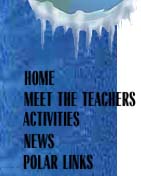
|
TEA What is TEA? TEA is a program sponsored by the National Science Foundation (NSF) in which teachers are selected to travel to the Antarctic and the Arctic for a field season to parcticipate in ongoing research. TEA is a partnership between teachers, researchers, students, the school district, and the community. What are the goals of TEA? What does TEA stand for? TEA is an acronym for Teachers Experiencing Antarctica or the Arctic. Context is everything! Another common usage: TEAntarctic and TEArctic. How did the TEA program get started? TEA has its origins in the Young Scholars Program. Originally, high school students were selected to go to the Antarctic. Many of these students graduated, limiting their impact in the classroom in the following year. In 1992, Mr. Peter Amati of Holliston High School in Holliston, Massachusetts, accompanied one of his students to the orientation workshop. Knowing one of the goals of the program was to extend the experience into the classroom, he suggested that teachers should also go to Antarctica. The teachers could maintain contact with other teachers, the students, and the community. That year marks the initiation of the TEAntarctic program as Mr. Amati and four other teachers headed south. The TEArctic program began in 1995 with Mr. Tim Buckley joining a research expedition. The following season three teachers parcticipated as members of Arctic research teams, solidifying the TEArctic component of the Polar TEA program. Who is funding the TEA Program? TEA is funded by the NSF branches of the Division of Elementary, Secondary, and Informal Education (ESIE) in the Directorate for Education and Human Resources (EHR) and the Office of Polar Programs (OPP). Such joint funding is rare in NSF, but reflects the strong commitment to the integration of science education and research. How do teachers get involved? ESIE sends requests for teacher nominations to Principal Investigators (PI) funded for NSF sponsored teacher enhancement/research projects. The PIs nominate teachers, and in some cases, students. Teachers also may nominate themselves for consideration. The teachers are responsible for completing an extensive application. Concurrently, OPP requests PIs funded through its office to indicate interest in working with a teacher during the field season. Once the teachers and the researchers have been identified, ESIE and OPP work together to identify teacher/researcher pairs. Who pays for TEA parcticipation in the program? The NSF covers costs for meetings and workshops, transportation, the required medical examination, and the substitute teacher. Cold weather gear is provided on loan to the Arctic teachers by the Polar Ice Coring Office (PICO). Antarctic teachers receive clothing and equipment from the United States Antarctic Program (USAP). How many TEA teachers are involved each year? The number varies, depending on the funding level available to the program each year. In 1997/98, five teachers went to Antarctica and three teachers went to the Arctic. Twelve teachers will be parcticipating in the 1998/99 field season. Four will explore the Arctic; eight will venture to the Antarctic. What is required of the TEA parcticipants? The TEA applicant must: How are the TEA teachers trained? The new TEA parcticipants are mentored by past TEA teachers. They attend an orientation at the NSF in the late spring to become more familiar with the TEA program and responsibilities of TEA parcticipants. They also learn about the workings of the OPP and receive a briefing about the conditions and resources they can anticipate during their work in the field. For two to three weeks during the summer, the TEA parcticipants visit the researcher with whom they will be working. They become familiar with the science project and the technology that will be employed in the field. They receive training for their parcticipation in the research project; the teacher is a member of the research team. Some TEArctic teachers may go into the field first, and work at the researcher's institution to wrap up experiments and analyze results following the field experience. The Arctic field season extends from approximately March through September. The TEArctic teacher spends 2 to 8 weeks in the field during this window. The Antarctic season extends from approximately October through March. During this time, the TEAntarctic teacher joins an expedition for 4 to 8 weeks. After returning from the field, the TEA teachers may continue to collaborate with the research team. They may visit the research institution during the following year to complete the project, write their findings in journal arcticles, and involve their classroom in the research. What do TEA teachers do? One of the greatest responsibilities of the TEA teachers is to share their experience with others; few teachers and students will have an opportunity to travel to the polar regions and parcticipate in cutting-edge research. While in the field, TEA teachers convey their experiences, scientific and personal, back to classrooms through daily electronic journals, electronic communications with classes, and CU-SeeMe sessions. Once home, TEA parcticipants are charged with working with their school district to effectively bring the polar experience into the classroom. They mentor TEA Associate teachers, and collaborate to develop classroom activities and materials that grow from their experiences and research. TEA teachers must present their experiences to the community, and parcticipate in national education meetings and workshops. TEA teachers take a lead role in the Polar Learning Community. Back to: TEA Information Front Page |
